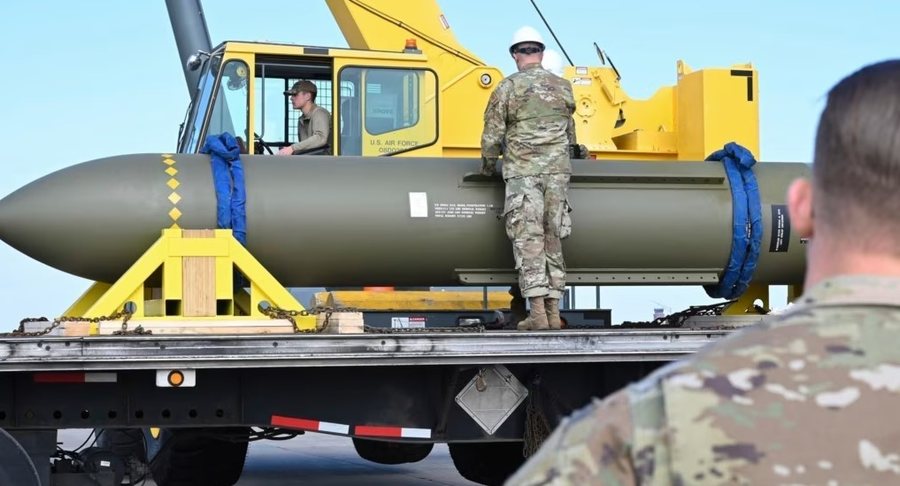
The conflict between Israel and Iran carries many unknowns: whether Israeli airstrikes on Iranian nuclear facilities could cause the release of radiological materials; whether the Israeli offensive could turn into a campaign for regime change; and whether the United States could become directly involved in war with Iran.
But, rumors in the media have focused particularly on one possible scenario.
Key parts of Iran's nuclear complex are built underground, and reports have focused on one particularly fortified target - the uranium enrichment plant in Fordow, in Qom province, about 150 kilometers south of Tehran.
The Fordow facility is built deep inside a mountain, in a complex of tunnels built for Iran's Islamic Revolutionary Guard Corps (IRGC). Its existence was revealed in 2009, through a joint statement by US President Barack Obama, French President Nicolas Sarkozy and British Prime Minister Gordon Brown.
"Iran has the right to develop peaceful nuclear energy that meets the energy needs of its people," Obama said at the time. "But the size and configuration of this facility are not consistent with a peaceful program."
Tehran subsequently acknowledged the existence of the facility, which would eventually be included in the Joint Comprehensive Plan of Action (JCPOA), which limited Iran's nuclear program.
US President Donald Trump withdrew from the deal during his first term as part of a so-called "maximum pressure" campaign on Tehran; Iran responded by accelerating its nuclear program.
The state of affairs today? According to the International Atomic Energy Agency (IAEA), the Fordov plant is producing uranium enriched to a level of 60 percent — a major step towards weapons-grade material, suitable for making a bomb.
“The status of Fordow now or after any further attack will be crucial to Iran’s nuclear future, as it is believed to be the facility where enrichment can be increased from 60 to 90 percent to weapons-grade uranium,” wrote Heather Williams, director of the Nuclear Issues Project and senior fellow in the Defense and Security Department at the Center for Strategic and International Studies in Washington, in a commentary following the start of the Israeli attacks on Iran.
"Another concern is that Fordow could be one of the places where Iran has stockpiled 60 percent enriched uranium, or where this stockpile could be moved," Williams added.
What is a “Bunker Buster” and would it work against Fordow?
The IAEA now estimates that an Israeli strike succeeded in hitting an underground enrichment facility at Natanz. It is not known exactly what type of munitions were used in that attack, but the Israeli military possesses bombs capable of penetrating underground before detonating.
An open-source analysis by the New York Times, based on footage of the aircraft used in the strike that killed Hezbollah leader Hassan Nasrallah last year, concluded that they carried 900-kilogram American bombs equipped with JDAM (Joint Direct Attack Munition) guidance kits, which precisely guide the bomb to its target.
These bombs — known as “bunker busters” — brought down several multi-story buildings. But the Fordov facility is a much more difficult target, as it is located deep underground.
This has prompted a wave of speculative media reports about a weapon not available to the Israelis: the GBU-57 A/B Massive Ordnance Penetrator (MOP), a bomb in the US military's arsenal.
According to an article published in 2007 by the Defense Threat Reduction Agency, the US Department of Defense agency that funded the development of this bomb, the 13,600-kilogram MOP is “designed to destroy deeply entrenched and fortified targets, such as bunkers and tunnel complexes.”
A report from the Office of the Director of Operational Test and Evaluation at the US Department of Defense says that the B-2 Spirit stealth bomber is the only aircraft that can use the MOP (Massive Ordnance Penetrator) bomb.
Whether MOP could be used against Fordov — and whether it would be able to disable this facility — still remains a hypothetical matter.
Trump's rhetoric toward Iran has hardened in recent days, but it is still unclear whether the US will directly intervene in a bombing campaign against Iran and send B-2s to strike Fordow.
Meanwhile, discussions about the technical capacity of weapons overlook a key aspect of any debate about armaments: their destructive power.
For example, the Israeli military has already faced international criticism for using 900-kilogram bombs and other munitions in Gaza.
Human rights advocates say the use of such heavy weaponry in dense urban areas is unclear in its targeting and disproportionate. The United Nations Human Rights Office published a report last year on six Israeli Defense Forces attacks in Gaza that caused more than 200 civilian casualties.
Fordow is not located in a densely populated area, and comparisons between conflicts are never accurate. But some observers have also questioned whether a successful attack on the facility would actually delay Iran's nuclear program.
"The deep-seated enrichment plant at Fordow was not hit on the first night of the attack," wrote Mark Fitzpatrick of the International Institute for Strategic Studies in an online analysis.
"However, it could be targeted in the operation that Netanyahu announced in a televised speech the same day. It is not known whether Israel has managed to destroy the 604 kilograms of 60 percent enriched uranium, U-235, that Iran has produced so far."
This amount is enough for ten or more nuclear weapons, if further enriched to the 90 percent level, which is considered weapons-grade. This stockpile can be easily transported and was likely the first thing to be hidden once Israel's bombing plans became clear."
In other words, "bunker busters" may get headlines, but high-profile attacks may not yield the expected results. REL
(A2 Televizion)











